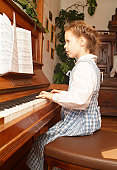
Home > Music Theory > Dynamics
|
||||
Physical Dynamics of Piano Playing
The piano player plays the strings by pressing down on a key, which causes the hammer to strike the string to produce the note. The piano player does have some control over the amount of force the hammer strikes the string with, which is what is used to create physical dynamics during playing. Forte is the term that refers to using the hammer to strike the string with more force, producing a larger sound. A forte note or section is marked with the letter “f” written on the score. In order to produce a forte note, you need to press down harder on the key than when you normally play notes. Once you have struck the note, you can immediately release the key. There is no point to holding down the key when playing a forte note on a piano. Once struck, the note is as loud as it is going to get. Forte notes are usually used to emphasize or call to attention certain sections of a song. If you pay attention to many songs, you can hear certain sections are louder than others. In some cases, this dynamic is created by having more instruments playing at the same time. If the number of instruments used in the song is constant, forte dynamics are used to create that build up.
You need to balance between creating a softer note and creating an audible note. The audience still needs to clearly hear the piano notes in a piano dynamic section. It takes some practice to hit the key hard enough to create a clear note, but soft enough to be audibly weaker than the rest of the song. The physical dynamics of piano playing have further classifications beyond “forte” and “piano.” The same piano technique is used to play these other dynamics, but the amount of force used varies much more significantly. For example, mezzo-forte notes are still louder than a normal note, but softer than a normal forte note. Mezzo-piano notes are still softer than a normal note, but louder than a normal forte notes. Fortissimo notes are played even louder than a normal forte note. Pianissimo notes are even softer than a normal piano note, but still need to be loud enough to be audible. Electric keyboards do not produce sounds by striking a string with a hammer, like a piano. Some really low end keyboards cannot be used to play any sort of physical dynamic. The reason is because the keyboard only registers as being on or off, so the note is equally loud no matter how hard the string is pressed. Higher end keyboards have velocity sensors installed in the keys, which measure the amount of force used to play the key. A keyboard with velocity sensors has the same physical dynamic techniques as a piano. The only difference is the synthesizer in the keyboard is simulating the dynamic rather than it being generated through a physical vibration.
http://pianoplayerworld.com/MikeBerealMasterClass.html
| ||||
|
Although every attempt has been made to make information as accurate as possible, we are not responsible for any errors that may appear.
 The physical dynamics of
The physical dynamics of 
 The physical dynamic of piano playing that refers to playing notes more
softly than normal is “piano.” A piano dynamic note or section is marked with the letter “p” in the score. In
order to play a piano note, you press down softer on the key than your normal playing. The piano dynamic is
the more difficult physical dynamic to play in most cases.
The physical dynamic of piano playing that refers to playing notes more
softly than normal is “piano.” A piano dynamic note or section is marked with the letter “p” in the score. In
order to play a piano note, you press down softer on the key than your normal playing. The piano dynamic is
the more difficult physical dynamic to play in most cases.



